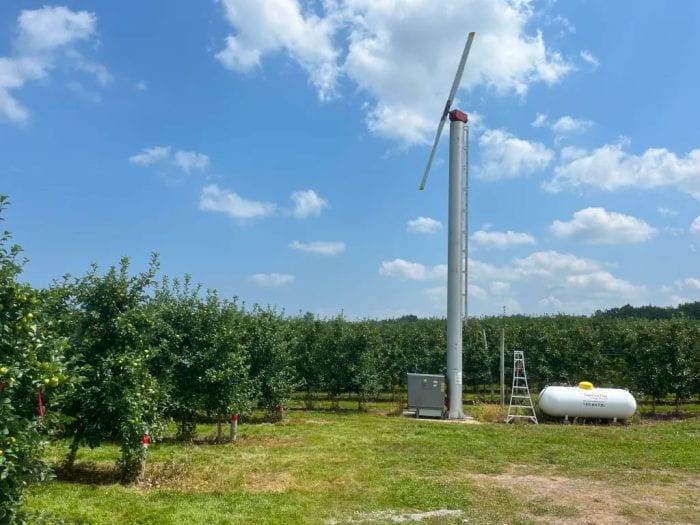
Wind machine at a New York orchard. Wind machines mix the cold air near the ground with warmer air from higher up, raising the temperature of the air around the trees and reducing the risk of frost damage. Photo by Deborah Aller
By Blaine Friedlander
New York’s farmers are facing more extreme weather caused by climate change and they are learning to adapt, according to the agriculture chapter of the new statewide climate impacts assessment, led and written by two Cornell researchers.
“We need to be adapting,” said Deborah Aller, extension associate in the Soil Health Program, School of Integrative Plant Science Soil and Crop Sciences Section in the College of Agriculture and Life Sciences (CALS). “These one-in-100-year weather events, for example, are becoming a lot more frequent and extreme. We need to increase agriculture’s preparedness and farmers’ ability to respond rapidly to the impacts.”
Aller, with Allison M. Chatrchyan, research associate in the School of Integrative Plant Science (CALS) and adjunct professor of environmental law at Cornell Law School, led the working group and wrote the agriculture chapter of the New York State Climate Impacts Assessment, released Feb. 2 by Gov. Kathy Hochul.
The overall assessment effort – which was announced in November 2021 – was led by the New York State Energy Research and Development Authority (NYSERDA). Beyond agriculture, the report focuses on how climate change will impact all sectors of the state economy, including: energy; human health and safety; buildings; ecosystems; society and economy; transportation; and water resources.
The general assessment – which supports New York state’s environmentally comprehensive Climate Leadership and Communities Protection Act (CLCPA), a law passed in 2019 – found that extreme temperature, precipitation and drought events will likely increase in New York during this century.
The average temperature statewide has increased by almost 2.6 degrees Fahrenheit from 1901 to 2022. In fact, the warmest 10-year periods in New York’s history have occurred since 2000.
New York’s statewide mean temperatures are projected to increase – from 2.5 to 4.4 degrees Fahrenheit by the 2030s, 3.8 to 6.7 degrees by the 2050s, and 5.1 to 10.9 degrees by the 2080s – relative to a 30-year (1981–2010) baseline, the report said.
The report found that impacts to agriculture involve warmer winters, greater heat stress for animals and crops, more frequent short-term droughts and late spring freezes, increased pest (weeds, disease and insects) pressures and higher production costs.
In discussing the report, the authors explained how warm spring temperatures in 2023 caused budbreak in perennial fruit crops (apples and grapes), but a late-May freeze resulted in damage to the flowers, destroying much of the season’s crop.
The report called climate change a “threat multiplier” for the state’s farmers, meaning they already face several stressors, such as tight profit margins and labor shortages, and the impact of climate change exacerbates existing problems. But to farmers’ credit, many are implementing and investing in practices that make their farm businesses more resilient to climate extremes.
The assessment cites Stein Farms in LeRoy and New Moon Farms in Munnsville as examples of New York farmers taking action to dampen the effects of climate change.
Housing more than 1,000 cows, Stein Farms built a climate-controlled barn with insulated walls, ceiling fans and side curtains to keep the building cool in summer and warm in the winter. Further, the infrastructure collects and uses water efficiently.
At New Moon Farms, owners Chris Ficken ’12 and Sarah Ficken ’11 built a dairy barn that features compostable bedding, which lets the cows stand on a bed of sawdust instead of concrete. This minimizes methane emissions and allows spent material to double as compost for the crop fields, the report said.
Also in the report: The sea level along the state’s coastline has risen almost a foot in the past century, and is projected to increase by another 1 to 2 feet by midcentury. Enduring climate change escalates health and safety risks for New Yorkers, including risks to mental health, it said.
The state assessment includes a focus on cross-sector impacts, climate justice considerations and the disproportionate impacts on vulnerable communities.
“Climate change can prompt cascading impacts across many interrelated socioeconomic and environmental systems,” Chatrchyan said. “Impacts in other sectors can ultimately affect agriculture, and agricultural influences can lead to challenges in other sectors, such as human health and water resources.”
Farmers and farms across the state need more assistance, the report states.
“One of our key findings from this work,” Aller said, “is the need for greater technical support, financial assistance and research to support adaptation within the agricultural sector across New York state.”
“New York residents are experiencing the impacts of climate change in real time, causing ripple effects across our state’s agri-food sector and in every facet of our daily lives,” said Benjamin Z. Houlton, the Ronald P. Lynch Dean of CALS. “As New York’s land-grant institution, Cornell CALS is proud to have the opportunity to bring our collective expertise forward to prepare New Yorkers for the impacts of climate change and support them in mitigation strategies to continue to thrive.”
New Yorkers know well the devastating impact of storms, extreme heat and flooding due to our changing climate, Hochul said. “We are arming New Yorkers, businesses, municipalities and industries with the information and tools needed to improve community adaptation and resilience while continuing to lower emissions,” she said.
A version of this news item originally appeared in the Cornell Chronicle.